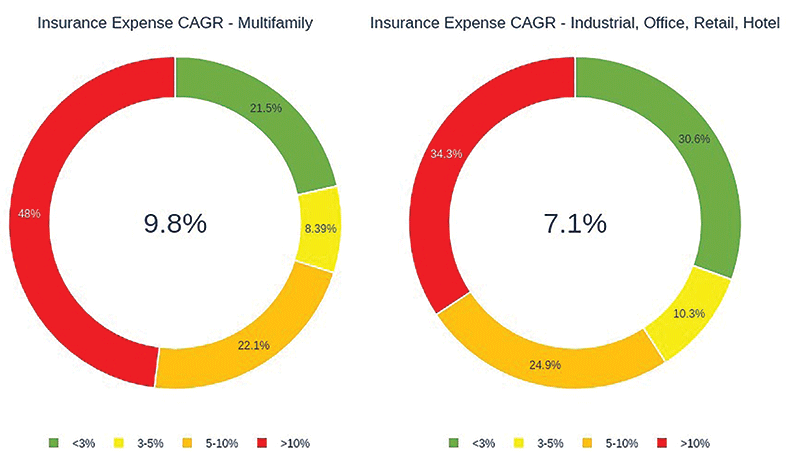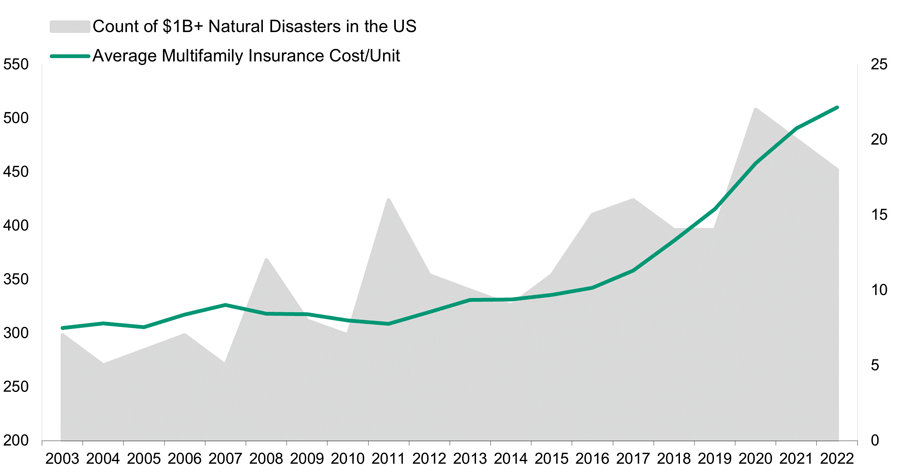Until recently, insurance was a straightforward part of commercial real estate transactions—an important component, but generally a simple check-the-box exercise with predictable annual increases aligned with inflation. In the past few years, things have changed drastically, with skyrocketing premiums that have jarring implications for underwriters and owners.
A critical safety net wears thin
保险费用用于每个是的稳步攀升r, but this predictability began to change in 2017, according to Moody’s Analytics’ analysis of 20 years of expense data on CMBS properties including multifamily, office, retail, industrial, and hotel (Fig 1). Looking at December values from 2017 to 2022, annual inflation rates from the Consumer Price Index (CPI) hovered around 2 percent, peaking at 7 percent at the end of 2021 with a compound annual growth rate (CAGR) of 3 percent across the period. However, the average insurance CAGR in the same period ranged from 6.7 percent to 9.8 percent across the five property types (Fig 2). Insurance expenses for multifamily are growing fastest among these five property types.
Figure 1. Average U.S. insurance premium by year and property type.

(Source: Moody’s Analytics CRE.)
Metros with the highest CAGRs for insurance premiums in the past five years are spread across the nation, with Texas, Sun Belt, Northeastern, and California metros tending to be on top. When comparing insurance expense CAGRs to rent CAGRs, insurance expense increases tend to outpace rent increases, offering some indication that revenue is not increasing at the same pace as insurance expense. For example, the top 20 multifamily metros for insurance expense increases range from 12.4 percent to 17.3 percent, whereas their rent CAGRs in the same period range from 2.8 percent to 7.7 percent, according to Moody’s Analytics.
Figure 2. Distribution of insurance expense CAGR (2017–2022) for
multifamily properties compared to the other four primary property types*

National average CAGR shown in middle of charts. (Moody’s Analytics CRE)
Several factors are driving skyrocketing prices in the insurance industry, including inflation, regulation, market structure, and climate change. Inflation increases the costs of materials and rebuilding, leading to higher claims. Social inflation, including litigation risk and other factors increasing the costs of claims above economic inflation, also contributes. Insurers rely on reinsurance—essentially insurance for insurers—which also faces similar pressures and rising rates, which reinsurers pass on to insurers.
Some insurers are choosing to pull out of whole markets, which reduces competition, further contributing to limited supply and high prices. For example, State Farm will no longer write new home or business property insurance policies in California, and Allstate stopped selling new homeowners insurance policies in the state in 2022. In recent years, dozens of insurers have pulled out of Louisiana and Florida, or have gone insolvent.
Figure 3. Multifamily insurance costs and U.S. natural disasters

(Sources: NOAA National Centers for Environmental Information (NCEI), Moody’s Analytics CRE, Moody’s Analytics CMBS)
The climate connection
The data generally shows that insurance premiums, following the same pattern as extreme events, are trending upward in recent years (Fig 3). A deeper look at the rate of change of insurance premiums does not show a correlation with exposure to climate hazards, according to Moody’s Analytics. Such data suggests that risk exposure is not yet priced in a systematic and consistent way.
However, there does appear to be a correlation between assets’ exposure to hurricanes and the insurance premiums of those assets. Moody’s Analytics found that when grouping assets based on their average annual damage estimates from hurricanes, based on Moody’s RMS data, the highest risk buckets tend to have the highest insurance premiums. Although insurance premiums are often sized by the value and revenue of a commercial real estate property, and higher-value and higher-revenue commercial real estate properties are often located in coastal areas with higher exposure to hurricanes, this trend held, even when looking at insurance costs as a share of revenue.
This relationship between hurricane exposure and insurance expense aligns with anecdotal evidence that hurricanes are a driving force behind insurance challenges in the Gulf Coast region. It also demonstrates how climate change interacts with other insurance market factors. For example, the property insurance landscape in Florida consists mostly of small, nondiversified companies. Thus, if a hurricane hits, it’s likely to affect many properties in those companies’ underwriting portfolios, presenting significant financial challenges.
Although wildfire’s contribution to pricing is not yet showing up clearly in the data, wildfire in California is causing financial impacts to insurers. According to Moody’s Investors Service, California, property and casualty insurers and their reinsurers had $36 billion in losses from the 2017 and 2018 wildfires, with their 2017 loss ratio over 200 percent.
Danielle Lombardo, a partner at Lockton, summarizes the issue: “Insurers are in the business of making money, and just when they think they’ve reached rate adequacy, there are significant catastrophe losses from weather events they hadn’t previously underwritten for, like severe winter freeze storms, hail, tornadoes, and wildfires. The first half of 2023, prior to the height of hurricane season, catastrophe losses are double the 10-year average.” This lack of profitability for insurers is affecting all other players in real estate markets.
Figure 4. Median insurance premium by year for retail properties grouped by their hurricane risk

(Moody’s Analytics CRE, Moody’s RMS)
Adjusting to the new era of risk
Market participants are facing overlapping challenges. Extreme events are causing unprecedented losses, both insured and uninsured, which result in business interruption and replacement costs that have implications for asset NOI and credit risk. However, this story is focusing on the insurance itself, where there is a growing risk that insurance expense inflation, alongside other expense increases, could outpace revenue growth. This trend presents a cash flow risk with implications for assets’ value, refinancing, and probability of default.
When it’s no longer possible to get full coverage with low premiums, there’s growing acknowledgement that something has to give. “The CRE Finance Council has convened a group of capital markets, CRE, and insurance experts to try and sort through this very significant and rapidly growing problem,” says Sairah Burki, managing director, head of Regulatory Affairs & Sustainability, CRE Finance Council. “We are currently examining key insurance and climate peril trends, identifying data needs, and thinking through potential policy solutions. We hope to present a sort of menu of solutions and policy considerations in the coming months.”
One solution would be to take a risk-based approach both to insurance requirements and to purchasing. Insurers use catastrophe models to set their pricing for hazards such as hurricanes, factoring in the probability of an event at an asset based on its location, as well as the amount of expected damage and business interruption based on multiple characteristics, including occupancy type, construction type, and elevation, among others. Coverage for a 1-in-1,000-year wind storm event, or one with a 0.1 percent chance of happening in a given year, would reduce owners’ premiums significantly compared to coverage for full replacement cost.
,仍有足够的空间or negotiation between a 1-in-1,000-year event and full replacement cost. If lenders become more comfortable with this approach to insurance requirements, owners will face less cash flow risk from insurance cost. Lombardo also underscores that this approach would “fix the supply and demand issues in states like Florida. If folks stop buying insurance they don’t need, there’s more insurance to go around.”
As catastrophe modelers increasingly offer climate-conditioned catastrophe models, this approach better accounts for increasingly volatile conditions. Currently, some states prohibit the use of catastrophe models for certain hazards, such as wildfires in California.
Owners can negotiate with lenders on insurance requirements and can look toward alternative sources of capital. For example, insurance-linked securities, such as public catastrophe bonds, provide (re)insurance capital from the public markets. Unlike traditional insurers, capital market investors have only a small sliver of their portfolio in catastrophe bonds, so they’re not holding too much risk from catastrophe insurance. After Hurricane Sandy, the New York Metropolitan Transportation Authority turned to the capital markets for insurance and issued a parametric catastrophe bond to cover risk from storm surge.
Elevating resilience and its ability to reduce risks across the market offers another potential solution. For example, last fall California’s insurance regulator mandated that insurance companies offer premium discounts for policy owners who implement certain risk reduction measures. Some state programs also provide grants or tax credits to offset certain resilience measures. Although many incentives focus on residential properties, several states have incentives for commercial owners. For example, Alabama gives commercial property owners a discount on insurance rates for building using the Fortified Commercial Standard (a voluntary construction standard focused on preparing buildings for high winds and rain). In Florida, the Hurricane Loss Mitigation Retrofit Grant funds updates that are focused on improving buildings’ resilience to flooding and winds, including commercial buildings. Mississippi also has programs to incentivize building for wind preparedness, including for commercial buildings.
去年,全球宣布了一项新的resil保险人调频ience credit, one offering premium reductions when clients invest in resilience measures. On the financing side, the National Energy Improvement Fund serves as a lender and insurer, helping to finance energy efficiency and resilience retrofits for both commercial and residential buildings. “There is a huge opportunity for insurers to leverage their understanding of asset risk to provide innovative services that incentivize risk reduction, such as offering premium discounts or even getting involved in the capital stack. Especially [with] insurers that focus on long-term relationships with their clients, there is room for innovation,” notes Theresa Lederer, lead consultant, at Moody’s RMS.
There is also room for brokers to help developers better understand which types of asset-hardening measures are factored in when insurers calculate premiums. As some solutions emerge, clearly there is a need for increased dialogue, negotiation, and innovation from all market participants, including insurers, lenders, brokers, risk modelers, owners, and policy-makers.
ULI will be further researching the topic of insurance in an upcoming report. If you would like to weigh in, please email Lindsay Brugger at[email protected]
NATALIE AMBROSIO PREUDHOMME is an associate director at Moody’s Analytics.

